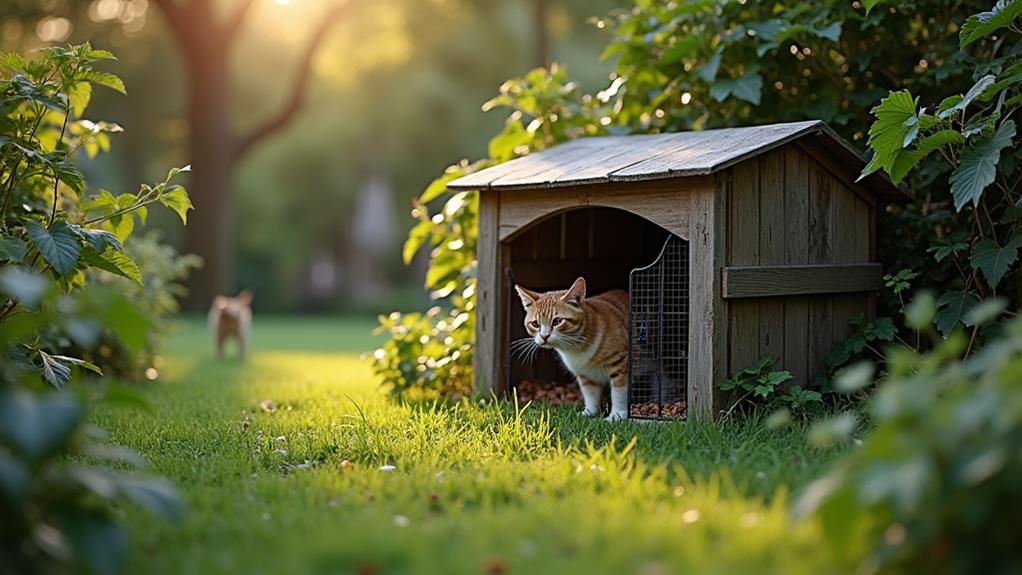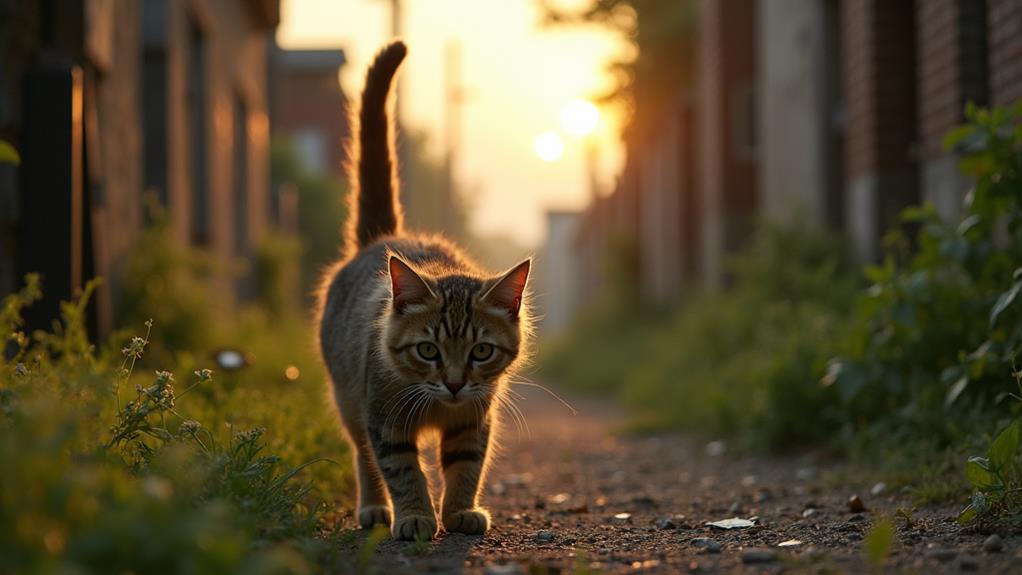How to Set a Feral Cat Trap: Effective and Humane Techniques

To set a feral cat trap effectively and humanely, start by establishing a feeding routine and set traps the evening before a clinic visit. Use strong-smelling bait like sardines placed at the trap's back and cover the trap with fabric to reduce stress. Always check traps at least every 30 minutes and verify they operate properly. Cover a captured cat with a blanket immediately for comfort and stay calm during handling. Involve the community to strengthen Trap-Neuter-Return efforts. With these steps, you can perfect the art of trapping while keeping the cats' welfare in mind, and there's more to investigate.
Preparing for Trapping
Before you begin trapping feral cats, it's essential to prepare properly to guarantee success and minimize stress for the animals. Start by establishing a consistent feeding routine for the community cats at the same place and time for at least three days. This will make the feral cats comfortable and familiar with the location, encouraging them to visit the traps. When you're ready to start the trapping process, set the traps the evening before the clinic appointment. Place food behind the trip plate in each trap to increase the likelihood of a successful capture.
Make certain the traps are lined with newspaper for added comfort and cover them with fabric to minimize stress once a cat is trapped. Check the traps frequently to confirm the humane treatment of the animals and avoid trapping in adverse weather conditions. This will reduce stress on the feral cats and improve the success of the trapping process. After capturing the cats, prepare a sheltered area for them post-clinic to guarantee their comfort and safety after surgery. By following these steps, you can trap feral cats in a way that's effective and humane, contributing positively to their well-being.
Choosing the Right Bait
Once you've prepared the trapping area, it's time to focus on selecting the right bait to attract feral cats efficiently. The choice of bait can greatly influence your trap's success. Opt for strong-smelling foods such as tuna, sardines, or canned mackerel. These potent aromas are particularly enticing to feral cats, making them more likely to enter the trap. Place the bait at the back of the trap to guarantee that the cat steps fully inside and onto the trigger plate, increasing the chances of a successful catch.
To improve your trapping efforts:
- Contain the bait: Use small paper plates to keep the bait tidy and prevent it from spilling outside the trap.
- Limit the quantity: This helps avoid attracting non-target animals and makes your trap more appealing.
- Experiment with options: Try jarred baby food or cooked chicken to see what appeals most to the specific cat populations you're targeting.
Additionally, make certain to remove any external food sources, so the feral cats are more motivated to investigate your trap. By carefully choosing your bait and setting it correctly, you can guarantee a humane and effective trapping process.
Monitoring and Safety

Effective trap monitoring and safety measures are essential in guaranteeing the humane treatment of feral cats. Once you've set your humane traps, check traps at least every 30 minutes. This frequent monitoring helps minimize stress and the risk of injury to the trapped cats. Keep a close eye on the trap door open and verify it functions correctly. Position traps on stable, level ground to prevent tipping, which could lead to injury or unnecessary stress for the cats.
When a cat is captured, cover the trap immediately with a blanket or towel. This simple step will reduce panic and stress for the animal while it waits for transport. Remember, never leave traps unattended. Staying nearby is imperative for the safety of the trapped cats, allowing you to respond quickly if something goes wrong.
Prepare yourself with proper handling techniques, such as wearing gloves and using calm approaches, to manage the captured cats safely. Proper handling reduces anxiety and guarantees that both you and the cats remain safe. By following these steps, you'll maintain the safety and well-being of the cats throughout the trapping process, making the experience as humane as possible.
Handling and Recovery
Handling a feral cat after capture requires care and patience to guarantee both the cat's safety and your own. Once a cat is trapped, monitor traps frequently, ideally every 30 minutes. This vigilance helps reduce stress and guarantees the cat remains secure. Immediately cover traps with a blanket or towel. This simple action not only reduces stress during transportation but also calms the animal.
After surgery, it's essential to follow clinic guidelines for post-surgery care. Keep the cat in the trap for recovery to prevent injury and facilitate safe handling. Make sure they have a quiet area for holding post-clinic. This environment aids in their recovery and reduces anxiety before release.
Here are key steps to follow:
- Monitor traps frequently: Check every 30 minutes to guarantee the cat's safety and minimize stress.
- Cover traps: Use a blanket or towel immediately to calm the cat during transportation.
- Post-surgery care: Follow guidelines and provide a quiet area for recovery.
Before releasing the cat, always check for ear tipping. This mark identifies spayed or neutered cats, preventing unnecessary future trapping efforts. By handling them humanely, you guarantee the success of your trapping efforts.
Community Involvement

After guaranteeing the safe recovery of feral cats post-surgery, the next step involves engaging the community in your efforts. Engaging local community members in TNR (Trap-Neuter-Return) initiatives is vital for creating a collaborative environment to manage feral cat populations effectively. Begin by educating neighbors about the benefits of TNR. Address their concerns directly to increase support and reduce misunderstandings about community cats. This understanding can lead to broader participation and advocacy.
Involve community volunteers in the trapping process. Their involvement not only shares the workload but also promotes awareness and advocacy for feral cat welfare. Hosting informational meetings or distributing outreach materials can effectively communicate the goals and processes of TNR. These efforts improve community participation and guarantee everyone understands the importance of their role.
Collaborate with local shelters and veterinary clinics to access significant resources and support. This collaboration guarantees a more organized approach, providing the necessary support for TNR activities. By pooling resources and expertise, you can tackle feral cat management more efficiently. Remember, community involvement is key to a successful TNR program. The more you collaborate and educate, the stronger the community's support will be.




